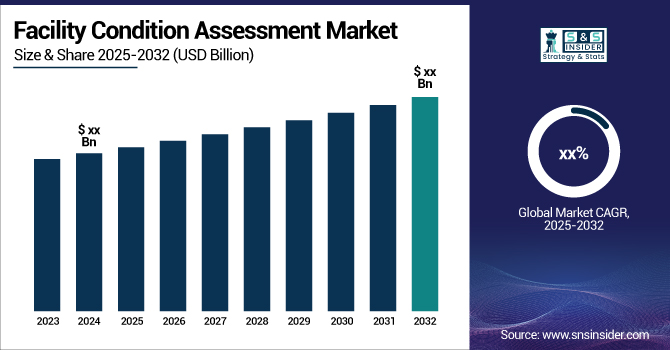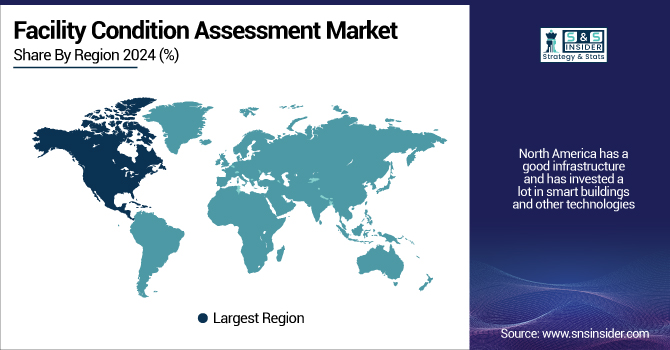Facility Condition Assessment Market Report Scope & Overview:
The Facility Condition Assessment Market size was valued at USD XX billion in 2024 and is expected to reach USD XX billion by 2032, expanding at a CAGR of XX% over the forecast period of 2025-2032.

To Get more information on Facility Condition Assessment Market - Request Free Sample Report
The facility condition assessment market growth is expanding substantially as companies focus on the useful life of assets, minimizing the cost of operations, and meeting mandatory compliance. FCAs are formal reviews of buildings to determine operational needs, safety hazards, and capital project planning. Predictive maintenance demand in healthcare, education, and government industries is driving the market growth. Advancements in technology, including drones, 3D modelling, AI, and BIM, improve the accuracy of assessment and give us predictive maintenance, which brings costs down. Increasing attention to save energy, to be green, and aging infrastructure drive the demand for facility condition assessment. These innovations are key facility condition assessment market trends, reshaping how inspections and maintenance planning are conducted.
According to resources, in the U.S., AI adoption remains modest, with the construction sector at just 4% and the manufacturing sector slightly higher at 12%, indicating limited integration across infrastructure-related industries.
The U.S facility condition assessment market size reached USD XX billion in 2024 and is expected to reach USD XX billion in 2032 at a CAGR of XX% from 2025 to 2032.
The U.S. presence of this market till now has been driven by mature infrastructure, a supportive regulatory framework, and widespread use of advanced technologies as drones, AI-enabled analytics, and BIM. The need for preventive operations, efficient power utilization, and environmental conservation is propelling the growth of FCA services in public, healthcare, educational, and commercial sectors. Federal requirements and funding also contribute to market growth in the U.S.
Facility Condition Assessment Market Dynamics:
Drivers:
-
Rising Emphasis on Predictive Maintenance and Infrastructure Optimization Drives Assessment Demand Globally
The growing necessity to preserve aging infrastructure, maximize asset performance, and minimize unplanned downtime is driving the demand for predictive maintenance approaches faster. Facility condition assessments are crucial for determining risks, setting priorities for repairs, and ensuring long-term cost-effectiveness. Companies are combining AI, IoT, and building information modelling to gain actionable insights from assessment information. Increasingly, municipalities and businesses are embracing data-driven maintenance planning to meet safety regulations and effectively manage operating budgets. Current trends involve the application of drones and digital twins to conduct facility assessments more quickly, safely, and accurately, further driving market adoption.
Restraints:
-
Lack of Standardization and Skilled Professionals Hamper Consistent Assessment Quality and Implementation
One of the most significant hindrances to the successful use of facility condition assessments is the lack of global standards across industries and regions. This leads to diverse methods of assessment and inconsistent reports, impacting decision-making and long-term planning. Moreover, a lack of trained professionals with experience in advanced diagnostic technologies and tools remains an impediment to scaling assessment services. Several organizations have been found to grapple with deciphering technical findings or incorporating them into general asset management plans.
Opportunities:
-
Growing Government Investment in Infrastructure Modernization Offers Strategic Opportunity for Service Providers
Government and institutional focus on modernizing public infrastructure has created a large opportunity for the growth of facility condition assessment service providers. Demand for condition monitoring to support capital planning and compliance is being fueled by federal and state funding of transportation hubs, healthcare facilities, and educational campuses. Discipline or simple optimization of their ability to upgrade their assets. These include infrastructure bills and stimulus packages, such as in the U.S., where energy efficiency audits and structural assessments are now required before budgets are approved.
Challenges:
-
Data Security and Privacy Concerns in Digital Assessment Platforms Present Long-Term Implementation Challenges
Data security and privacy digital tools, including cloud-based software, IoT sensors, and mobile data collection, have been widely used in FCAs, and the importance of data security and privacy is becoming more pronounced. Concerns over data leakage from facility condition assessment software platforms have made some organizations cautious about full-scale digital implementation. Gaining access to sensitive building information, such as blueprints and structural weaknesses could pose a major risk. Safe storage of encrypted data and regulation-compliance in soft targets and critical infrastructure, such as lack of hardened hospitals, airports or government, continues to be a challenge.
Facility Condition Assessment Market Segmentation Analysis:
By Type
The Structural Integrity Assessment segment generates the highest market share in Facility Condition Assessment Market due to its pivotal position for building safety, longevity, and regulatory compliance. Structural assessments constitute the core component of facility analyses, enabling stakeholders to recognize basic risks, deterioration of materials, and hazards. In recent developments, Terracon supplemented its structural diagnostic services with cutting-edge non-destructive testing equipment, while ISES Corporation introduced AI modeling to lifecycle structural forecasting. These additions reflect the rising demand for predictive maintenance and asset longevity, corresponding with the overall market shift towards data-driven, preventive facility maintenance.
The HVAC and mechanical systems evaluation accounts for the fastest-growing segment. HVAC and mechanical system assessment in a period of rapid expansion as best practices require greater levels of energy-saving from buildings and the preservation of the best that an indoor environment can be. The market is driven by government policies to promote sustainability and reduce carbon. Technologies, such as Johnson Controls’ AI-driven HVAC optimization apps and Carrier’s smart diagnostics, are improving reliability and performance.
By Application
The industrial and manufacturing plants segment held the largest facility condition assessment market share. The industry’s reliance on uninterrupted operation and compliance with safety regulations drives high demand for facility condition assessments. Manufacturing environments require constant monitoring to detect leaks, reduce depreciation, and optimize resources for compliance and operational efficiency. Across the Facility Condition Assessment Industry, education is emerging as a key vertical due to aging infrastructure and safety mandates. Facility condition assessment (FCA) Market Companies such as ABB and Rockwell Automation have introduced industrial analytics solutions that enable condition-based analysis, leading to the dominance of this segment.
The educational institutions & campuses segment is growing at a significant pace as infrastructure ageing, safety regulations, and energy usage become more of a concern in learning institutions. Schools and universities are increasingly focused on upgrading to meet compliance standards for accessibility and environmental standards. Recent changes include alliances such as Gordian’s focused asset management solutions and ARUP's assessment technologies, designed for the educational sector.
Regional Analysis:
North America has a good infrastructure and has invested a lot in smart buildings and other technologies, such as information technology and analytics tools for keeping the facilities safe and secure. The region’s emphasis on predictive maintenance, sustainability, and digitalisation in facilities management generates high demand for assessment services in areas such as education, healthcare and manufacturing.
The U.S. holds a large share in the market, which is being led by the development of infrastructure, along with a superior facility management infrastructure and enhancement of IoT and AI evaluation technologies.
Europe’s market is growing due to the increased investment in sustainable infrastructure and strong energy efficiency regulations. A growing amount of building stock in many countries is getting older, and therefore, the need for regular evaluation for safety and performance has increased. There are partnerships between the public and private sectors, and funding lines by the EU also drive growth of the region.
Germany leads Europe with its commercial and industrial base, proactive building standards, and adoption of smart facility monitoring and sustainability-focused retrofit programs.
The Asia Pacific is the fastest-growing region, which is driven by accelerated urbanization, government investments in infrastructure, and the modernization of commercial and industrial buildings. Besides, among the developing nations, there is a substantial investment in smart city projects and sustainable development fueling the growth of facility assessment technologies in a range of applications.
China leads the market, which has seen massive government investment in infrastructure along with strong government support for green buildings and rapidly growing education buildings driven by AI-based assessment platforms.
Middle East & Africa and Latin America are progressing at a steady pace, due to smart city initiatives, infrastructure upgradations, and increased emphasis on energy efficiency. In both regions, the government-led programs and increased private investment focus on the sustainability of asset management and safety.

Get Customized Report as per Your Business Requirement - Enquiry Now
Key Players:
The major players in the facility condition assessment market are ISES Corporation, Partner, FMX, Gordian, JS Held, Terracon, Limble, Bureau Veritas, SafetyCulture, Nelson Engineering, and others.
Key Developments:
-
April 2024 – J.S. Held acquired Failure Analysis & Prevention to strengthen its equipment consulting capabilities, enhancing its expertise in facility assessments across industrial sectors, such as power and construction.
-
November 2023 – Gordian partnered with Kinetic GPO to provide Building Intelligence solutions, including Facility Condition Assessments and capital planning tools, enhancing infrastructure planning for public sector organizations across Canada.

